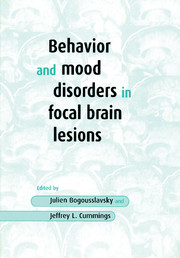Book contents
- Frontmatter
- Dedication
- Contents
- List of contributors
- Preface
- Acknowledgments
- 1 Emotional consequences of focal brain lesions: an overview
- 2 The evaluation of mood and behavior in patients with focal brain lesions
- 3 Methodological issues in studying secondary mood disorders
- 4 Emotional behavior in acute brain lesions
- 5 Depression and lesion location in stroke
- 6 Mood and behavior in disorders of the basal ganglia
- 7 Mania and manic-like disorders
- 8 Behavioral and emotional changes after focal frontal lobe damage
- 9 Disorders of motivation
- 10 Thalamic behavioral syndromes
- 11 Obsessive-compulsive disorders in association with focal brain lesions
- 12 Emotional dysprosody and similar dysfunctions
- 13 Temporal lobe behavioral syndromes
- 14 Neural correlates of violent behavior
- 15 Focal lesions and psychosis
- 16 Alterations in sexual behavior following focal brain injury
- 17 Anosognosia
- 18 Acute confusional states and delirium
- Index
10 - Thalamic behavioral syndromes
Published online by Cambridge University Press: 05 August 2016
- Frontmatter
- Dedication
- Contents
- List of contributors
- Preface
- Acknowledgments
- 1 Emotional consequences of focal brain lesions: an overview
- 2 The evaluation of mood and behavior in patients with focal brain lesions
- 3 Methodological issues in studying secondary mood disorders
- 4 Emotional behavior in acute brain lesions
- 5 Depression and lesion location in stroke
- 6 Mood and behavior in disorders of the basal ganglia
- 7 Mania and manic-like disorders
- 8 Behavioral and emotional changes after focal frontal lobe damage
- 9 Disorders of motivation
- 10 Thalamic behavioral syndromes
- 11 Obsessive-compulsive disorders in association with focal brain lesions
- 12 Emotional dysprosody and similar dysfunctions
- 13 Temporal lobe behavioral syndromes
- 14 Neural correlates of violent behavior
- 15 Focal lesions and psychosis
- 16 Alterations in sexual behavior following focal brain injury
- 17 Anosognosia
- 18 Acute confusional states and delirium
- Index
Summary
Introduction
The thalamus has been regarded as the primary ganglion of the brain and its importance is well recognized. It has complicated bidirectional and sometimes unidirectional connections with the cortical structures of the cerebral hemispheres, cerebellum, hypothalamus, and many brainstem nuclear structures. Almost all incoming information passes through the thalamus before finally arriving at its cortical destination. Most of the outgoing fibers from the cortex also send direct or indirect messages to the thalamus. Because the thalamus is buried deep in the brain and its nuclei are packed in such a compact mass, definition of clinical symptomatology caused by a specific nuclear lesion has been difficult. Even with today's neuroimaging technology, the symptomatology of each thalamic nucleus remains obscure, especially in the sphere of higher cognitive functions.
Anatomy
Before going into the details of clinical symptomatology, any confusion caused by the different terminology used in the literature should be clarified. In the literature different terminology appears. For instance, the terms mediodorsal nucleus (MD) and dorsomedial nucleus are used interchangeably. It is all the more confusing when the abbreviation MD is used together with the descriptive name of dorsomedial nucleus. In the official Latin terminological system (Nomina Anatomica), the general attribute comes immediately after the word nucleus, followed by the more restrictive attribute such as ‘nucleus medialis dorsalis (MD).’ In this chapter, the terminology of Carpenter's (1991: pp. 255-83) Core Text of Neuroanatomy, fourth edition is employed. According to this textbook, thalamic nuclei are divided into ten main groups (Table 10.1).
A more simple summary was presented by Nauta and Feirtag (1986): the lateral geniculate body (LGB), medial geniculate body (MGB) and ventral posterior nucleus (VP) belong to the specific sensory nuclei. They receive sensory.
- Type
- Chapter
- Information
- Behavior and Mood Disorders in Focal Brain Lesions , pp. 285 - 303Publisher: Cambridge University PressPrint publication year: 2000



